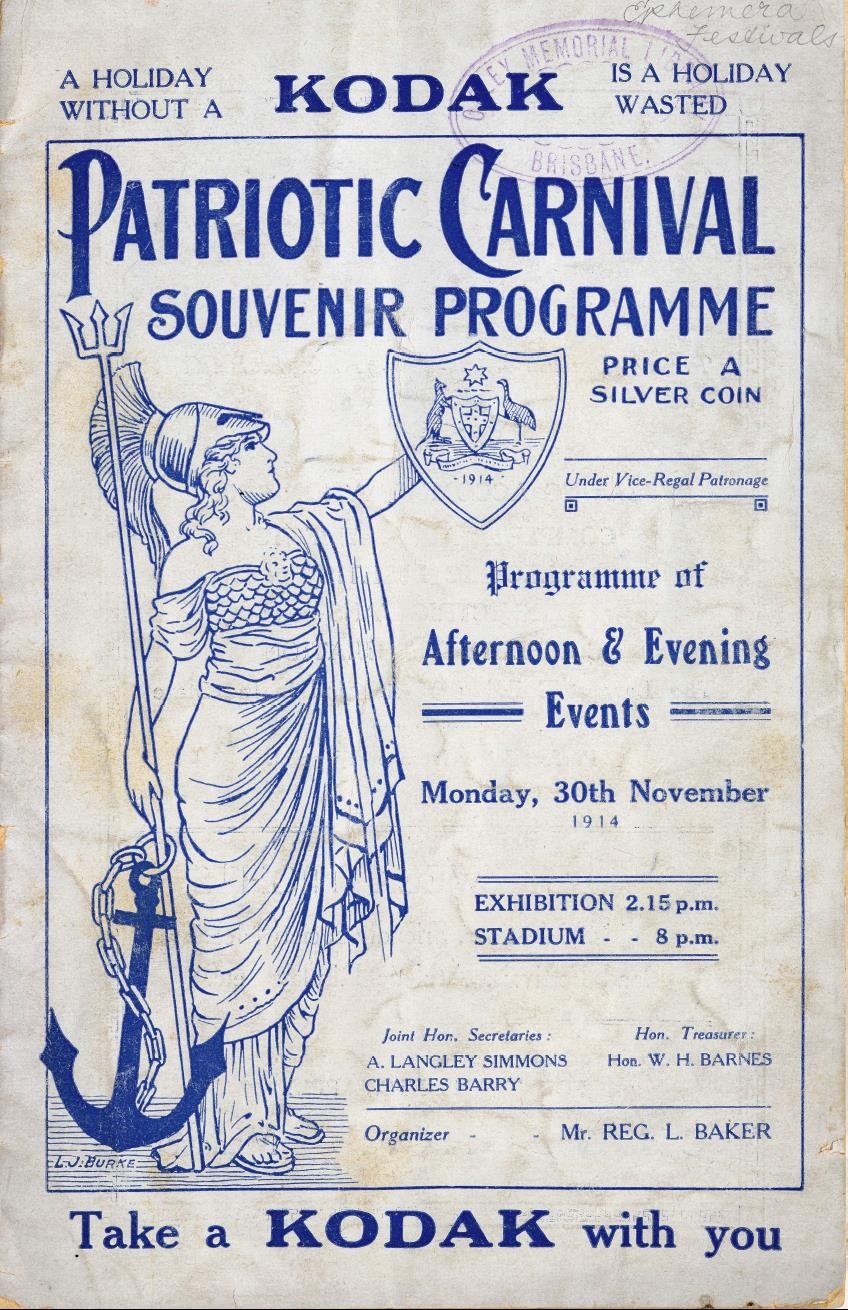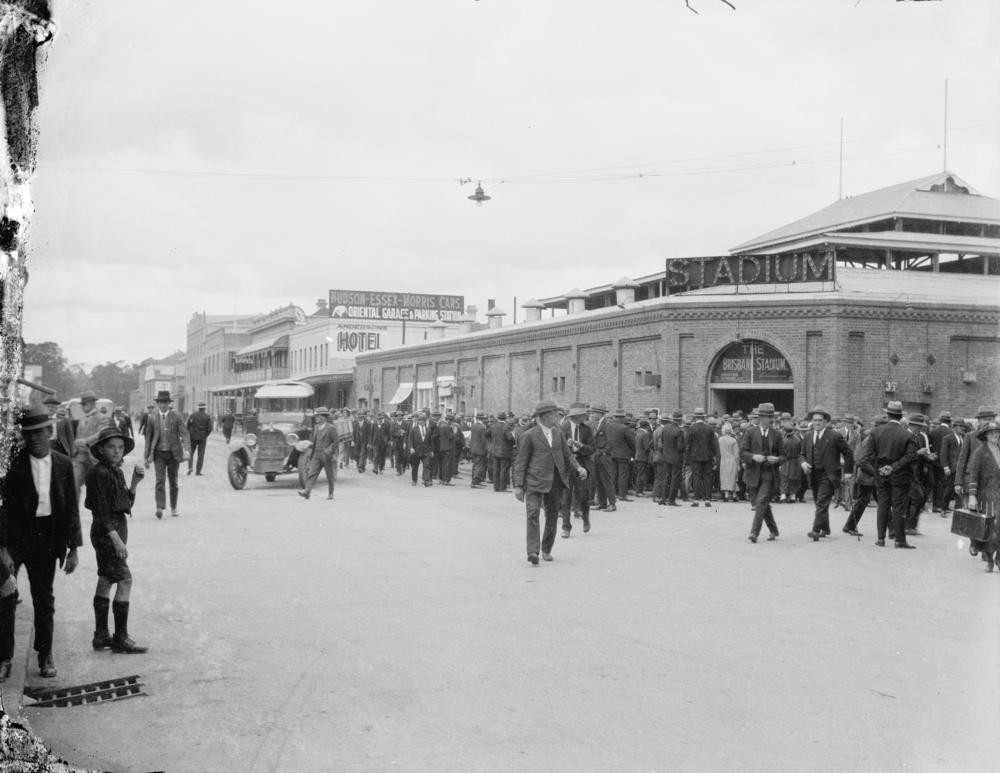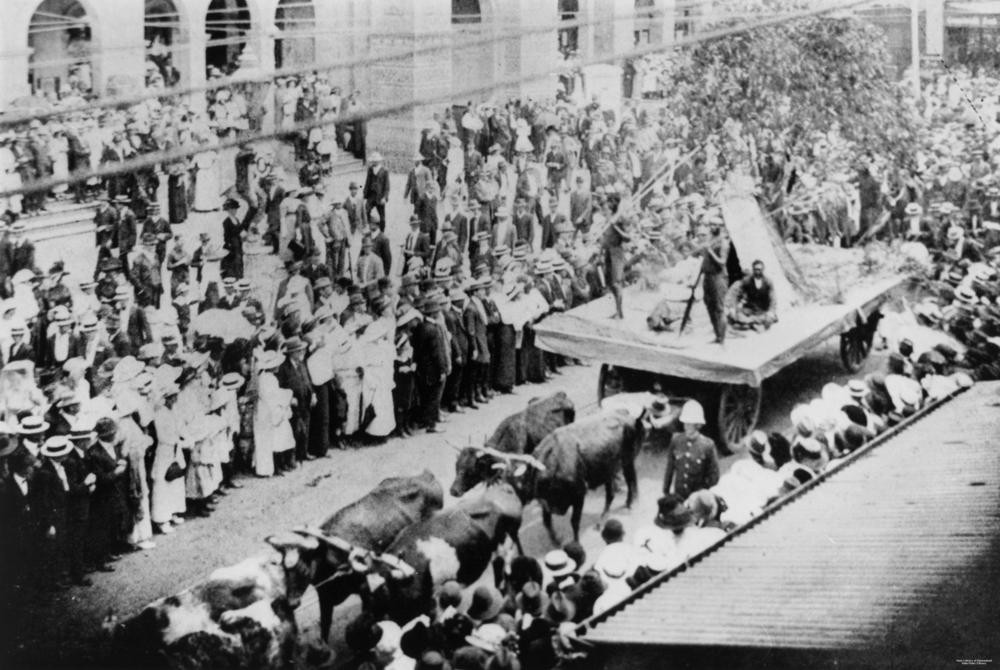Digitised@SLQ – Patriotic Carnival 1914
By Simon Miller, Library Technician, State Library of Queensland | 28 March 2014

Patriotic Carnival souvenir programme cover
One of the newly digitised items relating to World War One is a program for a Patriotic Carnival held on 30 November 1914. The organiser of the Carnival is listed as Reg. L. Baker and the venue for the evening events was Baker's Stadium, corner of Edward and Charlotte Streets. Reg 'Snowy' Baker is billed in his biography The Snowy Baker story as Australia's greatest all-round sportsman who excelled in 26 different sports. Certainly Snowy Baker represented Australia in Rugby Union, was middle-weight boxing champion of Australia and represented his country in the 1908 Olympic Games in swimming, diving and boxing, winning a silver medal in the middle-weight division. Snowy narrowly lost the final bout on points against the English champion J.W.H.T. Douglas after having to win three previous bouts on the same day to reach the final despite having only recently recovered from a bout of enteric fever and pneumonia.
In 1912 Snowy Baker got involved in the boxing stadium business, buying a Sydney stadium and soon acquiring stadiums in Brisbane, Melbourne and Adelaide. With the outbreak of the war, Baker tried three times to join the A.I.F. but was knocked back because of a spinal injury. Instead, Snowy Baker devoted his energy to organising fund raising events including the Patriotic Carnival in Brisbane.

Baker's Stadium pictured in 1925
The Patriotic Carnival opened with a grand parade through the city, finishing at the Exhibition Grounds, where the afternoon events were held. The Carnival was described in detail in the Brisbane Courier of 1 December 1914.
Hundreds of willing workers put splendid effort into the work of preparation, and the results were in all respects most gratifying. Public attention was, in the first place, centred upon the procession, which assembled in William-street. Long before the appointed hour of starting the streets were thronged, every balcony and window along the route being occupied. A few minutes after 1 p.m. the main streets were cleared of other traffic, and the procession moved off by way of Elizabeth, George, Queen, Wickham, and Brunswick streets to the Exhibition Grounds. Brisbane residents have witnessed many striking processions, but few have exceeded this one in length, and probably none have contained so many novel features. Mounted police led the way, and kept the line of march clear. Behind them came the members of the Queensland Motor Cycle Club, their machines gaily decorated, one built up to represent a gunboat, and two side cars containing ladies attired as nurses, who collected coins for the Patriotic Fund. A huge fleet of motor cars followed, "Coppers for our boys" being the sign which appeared to bring a liberal response to the occupants of one of these. The Caledonian Pipe Band headed a fine squad of Naval Cadets, under command of Chief Gunner Thorne, and they were followed by an individual in the grotesque garb of a Papuan medicine man. Senior Cadets, commanded by Captain Nevill, made a brave display, with their fife and drum band in the lead, the marching and general bearing of the lads being admirable. The Legion of Frontiersmen and the Boy Scouts were followed by the Municipal Concert Band. Then came the big reel of the Central Fire Brigade, and a fine turn-out of the several Volunteer Fire Brigades. On the reel of one of these was perched a native bear, clinging to a gum sapling, and nonchalantly chewing the leaves within its reach. Three little children in military uniform appeared rather crowded out of the procession, but they won a full share of the cheers which greeted the more notable features. The procession was picturesquely added to by an ambulance, with nurses and patients, a tableau representative of Britain and the Allies (Misses G. Nelson, M. and G. Hennequin, and A. Tainton), a car representing submarine E9, a splendid representation of Nelson's flagship Victory, with a correctly costumed Nelson on board, and Miss Violet Paget doing great work with a collection box : other cars built up to represent H.M.A.S. Sydney, the "Ahem-den," H.M.A.S. Ford, a car load of nurses, a lorry bearing a party representing India, and a contingent of 9th Australian Infantry. A lorry load of children represented the Belgian victims of the war, and as the crowd read the sign upon it "Great Britain keeps her promise"-they cheered again and again. Mr. Reg. L. Baker, the honorary organiser of the carnival, rode with the "Belgians," mounted on a sturdy charger. Then came representatives of the Allies, mounted, and wearing the national costumes ; a squad of Australian Light Horse ; two Roman chariots, with drivers in costume ; and a party of aboriginals on horseback. At their head rode the well-known aboriginal athlete, Jerry Jerome, bearing the Australian flag. Behind the mounted men came a team of 12 bullocks, drawing a lorry on which was a representation of an aboriginal gunyah, the warriors sitting round, and near them a kangaroo and native bear.

This Aboriginal display mounted on a bullock cart finished up the parade
Some 20,000 people crowded the Exhibition Ground for the afternoon entertainment.
Of what may be classed as the spectacular events, a fine display by the members of the Volunteer Fire Brigades deserved special mention. A party of aboriginal children from the Baramba settlement engaged in a Maypole dance under the direction of Miss A. Lipscombe. Fifty boys of the Normal School, under the direction of Mr. A. Dunlop, gave a unique display of boxing drill--something new and admirably executed. A Balaclava melee, Light Horse v. Infantry; a display by the naval cadets under Chief Gunner Thorne; wrestling on horseback, Light Horse v. Artillery, tilting the bucket by an infantry squad, wrestling on horseback, and racing over hurdles by infantry men were all items in which the several branches of the Defence Forces entered with great spirit. A feature which particularly appealed to the spectators was a display of spear, woomera, boomerang throwing by the Baramba aboriginals, and a corroboree by the warriors in their war paint.
These spectacles were interspersed with competitive events, the feature of which was a Roman chariot race. There were several cycling races, a billy goat race and a tug-of-war eventually taken out by the Fire Brigade team. One extraordinary sight would have been the race for bandsmen, playing their instruments, a handicap event determined by the weight of their instruments and won, almost unbelievably by J. Henderson, the kettle drummer of the 7th Australian Light Horse.
In the evening the focus moved to Baker's Stadium where the whole of the extensive seating accommodation of the large building was packed with one of the most fashionable audiences that have ever assembled in Brisbane.
The massed bands provided a programme of inspiriting patriotic airs, and the all-pervading sentiment of the throng was disclosed when the bands struck up the National Anthem, and every voice took up the moving strain.
The assembled crowd were then treated to a program of athletic displays, martial arts and novelty events such as a pie eating contest for newsboys and a hat-trimming contest for men. A comedy boxing display featuring Jerry Jerome, the first aboriginal boxer to hold a national title, and Welsh boxer Fred Dyer, known as 'the singing boxer' followed by an exhibition of blindfolded boxing finished the entertainment.
The Patriotic Carnival was a great success and raised over £2,200 for the Patriotic Fund. The Courier was keen to point out that a similar carnival in Sydney raised only £ 1,800.
Simon Miller - Library Technician, State Library of Queensland
Comments
Your email address will not be published.
We welcome relevant, respectful comments.